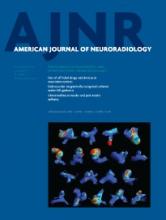Abstract
BACKGROUND AND PURPOSE: Secondary-progressive MS is characterized by reduced acute inflammation and contrast enhancement but with increased axonal degeneration and cognitive/clinical disability that worsens with advanced disease. Relative recirculation, extracted from DSC is a surrogate measure of BBB integrity. We hypothesized that normal-appearing white matter relative recirculation is reduced in cognitively impaired compared with nonimpaired secondary-progressive MS, reflecting more advanced disease.
MATERIALS AND METHODS: Cognitive performance was classified as impaired or nonimpaired by use of Minimal Assessment of Cognitive Function In MS test components. Demographic data, brain parenchymal fraction, WM lesion fraction, and weighted mean normal-appearing white matter relative recirculation were compared in cognitively dichotomized groups. Univariate and multivariate logistic regressions were used to study the association between cognitive test results and normal-appearing white matter relative recirculation.
RESULTS: The mean (SD) age of 36 patients with secondary-progressive MS studied was 55.9 ± 9.3 years; 13 of 36 (36%) patients were male. A highly significant difference between normal-appearing white matter relative recirculation and WM lesion relative recirculation was present for all patients (P < .001). Normal-appearing white matter relative recirculation in impaired patients was significantly lower than in nonimpaired subjects for the Symbol Digit Modalities Test (P = .007), Controlled Word Association Test (P = .008), and Paced Auditory Serial Addition Test (P = .024). The Expanded Disability Status Scale demonstrated an inverse correlation with normal-appearing white matter relative recirculation (r = −0.319, P = .075). After adjustment for confounders, significant normal-appearing white matter relative recirculation reduction persisted for the Symbol Digit Modalities Test (P = .023) and the Paced Auditory Serial Addition Test (P = .047) but not for the Controlled Word Association Test (P = .13) in impaired patients.
CONCLUSIONS: Significant normal-appearing white matter relative recirculation reduction exists in cognitively impaired patients with secondary-progressive MS, localizing to the domains of processing speed and working memory.
ABBREVIATIONS:
- rR
- relative recirculation
- NAWM
- normal-appearing white matter
- SPMS
- secondary-progressive MS
- RRMS
- relapsing-remitting MS
- © 2013 by American Journal of Neuroradiology












